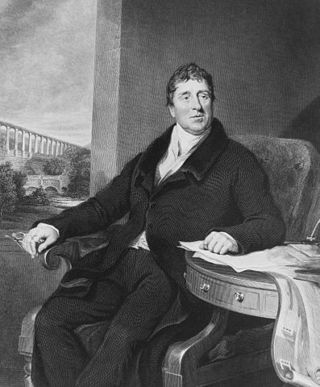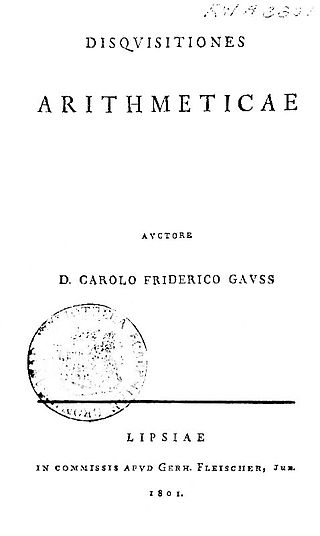Related Research Articles

Johann Carl Friedrich Gauss was a German mathematician, astronomer, geodesist, and physicist who contributed to many fields in mathematics and science. He ranks among history's most influential mathematicians and has been referred to as the "Prince of Mathematicians". He was director of the Göttingen Observatory and professor of astronomy for nearly half a century, from 1807 until his death in 1855.

Thomas Telford was a Scottish civil engineer. After establishing himself as an engineer of road and canal projects in Shropshire, he designed numerous infrastructure projects in his native Scotland, as well as harbours and tunnels. Such was his reputation as a prolific designer of highways and related bridges, he was dubbed the Colossus of Roads, and, reflecting his command of all types of civil engineering in the early 19th century, he was elected as the first president of the Institution of Civil Engineers, a post he held for 14 years until his death.
The year 1808 in science and technology involved some significant events, listed below.
The year 1787 in science and technology involved some significant events.
The year 1828 in science and technology involved some significant events, listed below.
The year 1838 in science and technology involved some significant events, listed below.
The year 1840 in science and technology involved some significant events, listed below.
The year 1874 in science and technology involved some significant events, listed below.
The year 1811 in science and technology involved some significant events, listed below.
The year 1792 in science and technology involved some significant events.
The year 1777 in science and technology involved some significant events.
The year 1847 in science and technology involved some significant events, listed below.
The year 1798 in science and technology involved some significant events.
The year 1797 in science and technology involved some significant events.

The year 1801 in science and technology involved some significant events, listed below.
The year 1786 in science and technology involved some significant events.
The year 1784 in science and technology involved some significant events.

Disquisitiones Arithmeticae is a textbook on number theory written in Latin by Carl Friedrich Gauss in 1798, when Gauss was 21, and published in 1801, when he was 24. It had a revolutionary impact on number theory by making the field truly rigorous and systematic and paved the path for modern number theory. In this book, Gauss brought together and reconciled results in number theory obtained by such eminent mathematicians as Fermat, Euler, Lagrange, and Legendre, while adding profound and original results of his own.
The year 1798 in architecture involved some significant events.

Navigable aqueducts are bridge structures that carry navigable waterway canals over other rivers, valleys, railways or roads. They are primarily distinguished by their size, carrying a larger cross-section of water than most water-supply aqueducts. Roman aqueducts were used to transport water and were created in Ancient Rome. The 662-metre (2,172 ft) long steel Briare aqueduct carrying the Canal latéral à la Loire over the River Loire was built in 1896. It was ranked as the longest navigable aqueduct in the world for more than a century, until the Magdeburg Water Bridge in Germany took the title in the early 21st century.
References
- ↑ Williams, Hywel (2005). Cassell's Chronology of World History . London: Weidenfeld & Nicolson. p. 346. ISBN 978-0-304-35730-7.
- ↑ Dunnington, G. Waldo (2004). Carl Friedrich Gauss: Titan of Science (new ed.). Washington, DC: Mathematical Association of America. ISBN 978-0-88385-538-6. OCLC 53933110.
- ↑ Hall, Tord (1970). Carl Friedrich Gauss: a Biography . Cambridge, MA: MIT Press. ISBN 978-0-262-08040-8. OCLC 185662235.
- ↑ Gauss, Carl Friedrich (1801). "§§365–366". Disquisitiones Arithmeticae. Leipzig.
- ↑ Waldman, Thomas A. (2003). "Immunotherapy: past, present and future". Nature Medicine . 9 (3): 269–277. doi: 10.1038/nm0303-269 . PMID 12612576. S2CID 9745527. Archived from the original (PDF) on March 3, 2009. Retrieved 2011-07-18.
- ↑ Graham, Patrick (2001). Phrenology: revealing the mysteries of the mind (videorecording (DVD)). Richmond Hill, Ont.: American Home Treasures. ISBN 0-7792-5135-0.
- ↑ "Benjamin Outram (1764–1805)". Archived from the original on 18 July 2011. Retrieved 2011-07-18.
- ↑ Brown, Peter. "Thomas Telford" (PDF). Archived from the original (PDF) on 2011-09-27. Retrieved 2011-07-18.
- ↑ Tyrrell, Henry Grattan (1911). History of Bridge Engineering. Chicago. pp. 153–154. Retrieved 2011-08-16.
{{cite book}}: CS1 maint: location missing publisher (link) - ↑ Troyano, Leonardo Fernández (2003). Bridge Engineering: a Global Perspective. London: Thomas Telford Publishing. p. 49. ISBN 978-0-7277-3215-6.
- ↑ "Sunderland Wearmouth Bridge". Wearside Online. Archived from the original on 2011-11-27. Retrieved 2011-08-16.
- ↑ Meggs, Philip B. (1998). A History of Graphic Design. John Wiley & Sons, Inc. p. 146. ISBN 978-0-471-29198-5.
- ↑ "Copley Medal | British scientific award". Encyclopedia Britannica. Retrieved 21 July 2020.